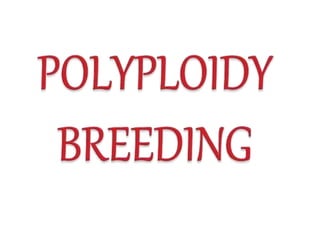
polyploidybreeding....pptx
- 2. POLYPLOIDY BREEDING It is a type of plant breeding that uses polyploid plants to produce new hybrid plants. Polyploidy is a condition in which a plant has more than two sets of chromosomes. This can happen when a plant’s cells divide incorrectly, or when a plant is exposé to radiation or certain chemicals.
- 4. Polyploidy
- 5. Suitability of a crop for polyploid breeding depends on following factors: ⦁ Crops which are not seed propagated(ie, vegetatively propagated crops where the economic part is not seeds) eg: forage crops, tubers, sugarcane, ornamentals ⦁ Allogamy / cross pollination eg: Poaceae against Leguminosae
- 6. ⦁ STEP 1 Artificial induction and/or collection of naturally occuring polyploids and their maintanence. ⦁ STEP 2 Detection of different kinds of polyploids. ⦁ STEP 3 Isolation and handling of polyploids.
- 7. Polyploid breeding includes: 1. Monoploid/Haploid breeding 2. Autoploid breeding 3. Allopolyploid/Amphi(di)ploid breeding 4. Aneuploid breeding
- 8. STEP 1 PRODUCTION OF HAPLOIDS i. By induced parthenogenesis ◦ Using incompatible or irradiated pollen, haploids can be obtained by parthenogenesis. ii. Through wide crosses ( cross with distant species) ◦ eg: Hordeum vulgare х Elymus areanus Monoploid barley
- 9. iii. Through chromosome elimination technique in distant crosses ◦ eg: Bulbosum technique H.vulgare х H.bulbosum (2n=2x=14) (2n=2x=14) Hybrid embryo Haploid barley (2n=x=7) (H.bulbosum chr. eliminated) eg: Solanum nigrum x S.luteum
- 10. iv. Cell culture/Tissue culture technique v. Anther culture technique by Guha and Maheswari ◦ Used in Datura, Nicotiana, Brassica, rice, wheat, triticale etc. ◦ Tanfeng is a haploidy derived rice variety developed in China(1976) vi. Through pollen culture ◦ Haploid pollen grains develop into haploid plants. ◦ Nicotiana – readily responding in anther & pollen culture. Technique to be followed varies depending on the species.
- 11. STEP 2 DETECTION OF HAPLOIDS i. Detection through genetic markers ◦ Use of recessive & dominant genetic markers associated with seedling characters such as hypocotyl colour is useful in early detection of haploids. ◦ Eg : In potato, a dominant purple spot is present on haploid embryo-helps to distinguish at seed stage. ii. Through plant morphology ◦ Haploid plants are inferior to diploids – shorter, less longer leaves, reduced in breadth, stomata & guard cells – smaller in size.
- 12. STEP 3 DIPLOIDISATION ⦁ Colchicine treatment – most effective & widely used method. ⦁ Acts as inhibitor of spindle formation during mitosis & causes duplication of homologus chromosomes ⦁ Colchicine is readily soluble in cold water, alcohol and chloroform but less soluble in hot water. ⦁ Used as aqueous solution – relatively unstable. So the solution prepared fresh before each application. ⦁ Affects only dividing cells-applied to actively dividing meristematic cells repeatedly at brief intervals.
- 13. ⦁ Includes triploid and tetraploid breeding I. TRIPLOIDBREEDING • Produced by crossing tetraploid and diploid (4n x 2n)
- 15. ⦁ Varieties Shonima & Swarna (2015) released from Kerala Agricultural University
- 17. II. TETRAPLOIDBREEDING ⦁ Produced by chromosome doubling from diploid plants
- 18. ⦁ Possible in tobacco, Petunia etc. ⦁ Autotetraploid maize has 43% more carotenoid content & vitamin A. ⦁ Successful in forage crops, ornamentals etc. Pusa giant berseem -1st autotetraploid variety (Egyptian clover) released for large scale cultivation – higher green fodder yield Vetiver variety – Sugandha – 11% more oil yield
- 19. ⦁ AMPHIDIPLOID – Allopolyploids diploid for all genomes present. ⦁ STEP 1 Production of F1 hybrids by interspecific and intergeneric crosses ⦁ STEP 2 Chromosome doubling by colchicine
- 20. DD)
- 22. 4
- 23. ⦁ Developed by Karpechenko Chr.doubling
- 24. ⦁ Combines yield potential and grain quality of wheat & disease and environmental tolerance (including soil conditions) of rye
- 25. ⦁ Irregular variation in chromosome no. ⦁ By meiotic irregularities such as non-disjunction or lagging behind in metaphase plate result in n+1 & n-1 gametes. These gametes fertilized by normal gametes produce aneuploids. ⦁ In desynaptic and asynaptic plants-a no.of univalents are seen in mid metaphase instead of bivalents which produce aneuploids ⦁ Triploid plants produce aneuploid plants ⦁ Tetrasomic plants produce aneuploid gametes resulting in aneuploid progeny.
- 26. THANK YOU...